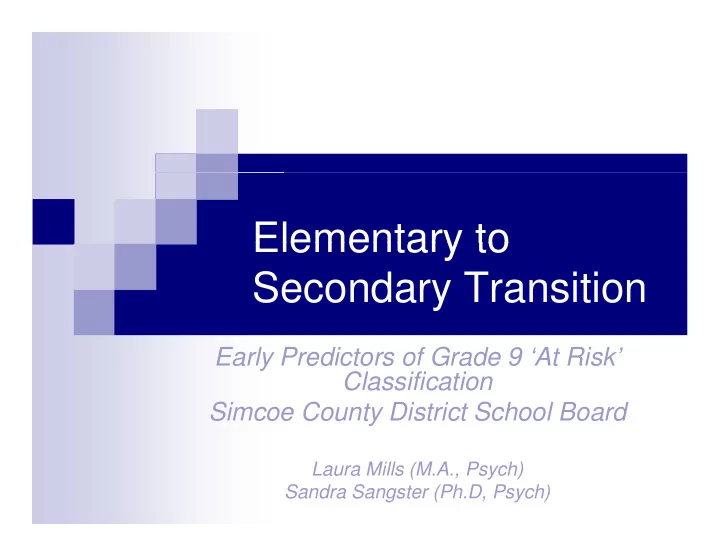

Elementary to Elementary to Secondary Transition Early Predictors of Grade 9 ‘At Risk’ Classification Classification Simcoe County District School Board Laura Mills (M.A., Psych) Sandra Sangster (Ph.D, Psych)
R Research Question h Q ti Initiatives Research Question Research Question Do grade 8 behavioural & academic predictors grade 9 risk? predictors grade 9 risk? Do behavioural and academic type indicators predict risk differently?
S Sample & Measures l & M SAMPLE: 2007-08 grade 8 cohort Students matched: 829 IEP, 3076 Non-IEP INDICATORS: Grade 8 Transition Profile Behavioural and Academic Indicators Grade 9 Grade 9 Number of classes ‘At Risk’ Percent of ‘Academic Level’ classes Credit Accumulation Absences Number of Suspensions EQAO Math Achievement METHOD: Structural Equation Modeling (MPlus)
P Predictors of Risk di t f Ri k Latent Variable Structural Equation Modeling Structural Equation Modeling Predictive Analysis
Personal Characteristics in G8 P l Ch t i ti i G8 Non-IEP Students o S ude s Self-Motivation 21% Self-Direction 15% Self-Discipline Self Discipline 13% 13%
EQAO PERSONAL CHARACTERISTICS PERSONAL CHARACTERISTICS -.2 # < 60% 1 .91 .8 Self-Motivation .90 .1 Self-Direction # Suspensions Personal .87 4.4 Discipline sc p e -.2 # Days Absent -.3 % Acad Level # Credits RMSEA = .034
Skill Levels Non-IEP St dents Students Numeracy Skills 13% Reading Skills Reading Skills 5% 5% Thinking Skills 7% Writing Skills W iti Skill 11% 11% Note-Taking 12% Organization 20% Oral Presentation 7% Prepared 16% Time Management 22%
SKILL LEVELS EQAO G General Students l St d t # < 60% .84 Numeracy 1 -.3 .91 91 .1 1 Reading 0 # Suspensions 0 Academic .81 .7 Thinking Skills .3 .84 .1 .1 W iti Writing -.2 -.1 # Days Absent 1.5 Note-Taking Note Taking 1 1 .85 -.1 Organization % Acad Level .84 Readiness Presentation Presentation .69 69 Skill Skills -.2 # Credits .90 Prepared .88 Time Management g RMSEA = .053
A Academic Issues d i I Non-IEP Students St d t IEP St d IEP Students t Assignment Completion 21% 56% Evaluation Results Evaluation Results 6% 6% 34% 34% Exam Performance 7% 37% Test Performance Test Performance 18% 18% 62% 62% Work Habits 22% 53% Work Independently p y 11% % 39% %
ACADEMIC ISSUES EQAO G General Students l St d t # < 60% Eval Results .89 1 -.2 0 0 .88 .2 Exam Performance # Suspensions Achieve- .7 0 .97 Test Performance ment .2 .6 -.1 -.1 # Days Absent 1.7 Assignment Completion Assignment Completion .95 95 1 1 .92 Work Habits % Acad Level -.1 Diligence .80 Independence Independence -.3 # Credits RMSEA = .044
Di Discussion i Behavioural patterns of students that are recognizable by teachers often predict g y p academic, engagement, and behavioural outcomes Many behavioural indices are amenable to change; note-taking organization time change; note taking, organization, time management, independence
N Next Steps t St Conduct ‘gender differences in risk’ Conduct gender differences in risk analyses Continue to track cohort for longitudinal Continue to track cohort for longitudinal analyses & predictors of success, risk, and dropout dropout Continue to track students through to the completion of grade 10 completion of grade 10 Begin dissemination of findings to inform programming i
Thank-you.
Recommend
More recommend